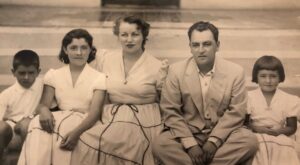Journalism
Is there such a thing as “the Latino voter”?
My father, a Peruvian, was something of a Republican, even when he wasn’t yet a citizen of the United States. For the first 15 years of my parents’ marriage, in Peru, he was mostly concerned with the careening allegiances of his own countrymen: the gaping divide between the elites and the poor; the wild, destabilizing vacillation between right wing and left wing in Latin America; the perpetual pendulum swing between oppression and revolution.
Read MoreNever before have things seemed so hard for Hispanics. The signals are stark and dire: A drowned father, cradling a dead daughter. A lone mother, defending herself against an armed Border Patrol agent, with a terrified toddler at her side. A diatribe hectoring whites to purge the country of a rising brown tide. A Walmart in El Paso, strewn with the dead. Caravans of the hopeful willing to suffer indignities, splinter their families, cower in cages, risk life itself for a distant dream.
Read MoreOne of Nigeria’s newest businessman, a slave trafficker for the modern age said: “I will marry out a female at 12; I will do same for a nine year old girl like it was done on my own mother. . . . I am the one that captured your girls and I will sell them…
Read MoreNadine Gordimer’s essay appeared in The Washington Post as part of Marie’s Book World series, “The Writing Life.” Scroll to the bottom to read Marie’s profile of the writer. The essay and profile can be found in the book, “The Writing Life.” August 5, 2001 Sunday A Nobel Prize-winner, on being a product of a…
Read MoreIn a series of guest Op-Ed columns for the New York Times, Marie explores a number of timely issues in Latin America, from poverty to Bolivarianism to new reverse-flow economies. THE KIDS LEFT BEHIND THE BOOM: March 20, 2013, Lima, Peru Henrry Ochochoque is a jovial 12-year-old with a report card full of A’s…
Read MoreGuest Columnist By Marie Arana Henrry Ochochoque is a jovial 12-year-old with a report card full of A’s and hopes pointed straight to the moon. Last year, he moved from the squalid gold-mining town of La Rinconada, Peru — at nearly 17,000 feet above sea level, the highest human habitation in the world — to…
Read MoreLa Rinconada, a gold mine at 18,000 feet in Peru, is the subject of this probing article, titled “Dreaming of El Dorado.” Marie traveled there to meet a young girl, Senna, and write a script for the forthcoming movie “Girl Rising.” The accompanying photographs are by Gina Nemirofsky of The Documentary Group in Los Angeles.…
Read MoreMarie has edited the Fall issue of the VQR (magazine published by UVA). Theme: “The Female Conscience,” featuring work by Jean Bethke Elshtain, Judith Warner, Joyce Carol Oates, Sylvia Earle, Mindy Aloff, Jonathan Yardley, Robin Marantz Henig, Reeve Lindbergh, Manal Al-Sharif, and many others. See more here.
Read MoreI once heard a master of suspense say that the craft was actually quite simple: Take a perfectly normal situation, a trope readers know well, then throw in a wild “what if?” What if your mild-mannered, homebody spouse — so familiar to you — is the midnight stalker in the black balaclava? What if the…
Read MoreA society dame with the shrill voice of a street vendor hides her lover upstairs, then steals up for nocturnal raptures. A gay king who can’t stomach his queen sends his most trusted courtier to impregnate her. A palace congested with vermin and lice harbors lamb chops and cakes tucked deep into the upholstery. A…
Read More
